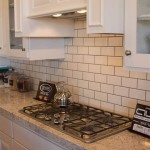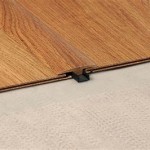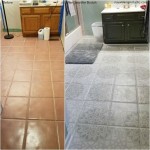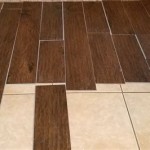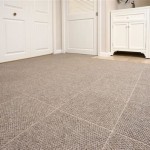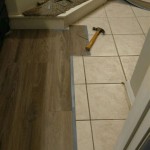Can You Lay Ceramic Tiles On Sand and Cement Board?
Ceramic tiles offer a durable and aesthetically pleasing finish for various surfaces, both indoors and out. Choosing the correct substrate is crucial for a successful tile installation. This article explores the suitability of sand and cement board as bases for ceramic tile projects.
Sand as a Substrate for Ceramic Tiles
Sand, in its pure form, is generally unsuitable as a direct substrate for ceramic tiles. Its loose, shifting nature prevents the necessary stable foundation required for adhesion. Movement in the sand base will inevitably lead to cracked grout, loosened tiles, and ultimately, a failed installation.
Mortar Beds over Sand
While sand alone is not recommended, it serves a vital role in traditional mortar bed installations. A mortar bed consists of a mixture of sand, cement, and water, creating a solid, level base for tiles. This method, commonly used for exterior applications like patios and walkways, provides a strong, durable foundation. However, it requires specific expertise and careful preparation.
The process typically involves compacting a layer of sand, followed by the application of a mortar bed. The tiles are then set directly into the wet mortar. This method offers excellent drainage and can accommodate slight irregularities in the underlying surface.
Cement Board as a Substrate for Ceramic Tiles
Cement board, also known as backer board, is a popular and reliable substrate for ceramic tile installations. Composed of cement, aggregates, and reinforcing fibers, it offers several advantages:
- Dimensional Stability: Cement board resists shrinking, swelling, and warping, providing a stable base for tiles.
- Moisture Resistance: It offers excellent resistance to moisture, making it suitable for wet areas like bathrooms and kitchens.
- Durability: Cement board is strong and durable, capable of supporting the weight of ceramic tiles and regular foot traffic.
- Ease of Installation: It can be easily cut and installed using standard tools.
Combining Sand and Cement Board
In some instances, sand and cement board may be used together in a tile installation. For instance, a mortar bed over compacted sand can provide the initial base. Then, a layer of cement board can be installed over the cured mortar bed for added stability and a smoother, more consistent surface for tile adhesion. This combined approach is particularly useful in outdoor applications where drainage and ground movement are concerns.
Key Considerations When Choosing a Substrate
Several factors influence the choice of substrate for a ceramic tile project:
- Location: Indoor or outdoor installations have different requirements. Outdoor installations often necessitate better drainage and resistance to freeze-thaw cycles.
- Subfloor Material: The existing subfloor, whether concrete, plywood, or another material, affects the choice of substrate.
- Tile Size and Weight: Larger, heavier tiles require a more robust and stable substrate.
- Moisture Levels: Areas exposed to moisture, like bathrooms and kitchens, require a moisture-resistant substrate.
Installation Best Practices
Regardless of the chosen substrate, proper installation techniques are essential for a successful tile project. These include:
- Surface Preparation: Ensure the substrate is clean, level, and free of debris.
- Proper Adhesive: Use the appropriate thin-set mortar or adhesive recommended for the specific tile and substrate.
- Grouting: Select a suitable grout and apply it correctly to fill the spaces between tiles and prevent water penetration.
- Expansion Joints: Incorporate expansion joints to accommodate movement and prevent cracking.
Understanding the Limitations of Sand
While sand plays a role in mortar bed installations, its limitations as a standalone substrate are crucial to understand. Directly applying tiles to sand will result in an unstable surface prone to cracking and failure. The shifting nature of sand prevents proper adhesion and long-term stability.
Choosing the Right Substrate for Your Project
Selecting the correct substrate is paramount for the longevity and success of a ceramic tile installation. Careful consideration of the project's location, subfloor material, tile characteristics, and potential moisture exposure will guide the appropriate choice between a mortar bed over sand, cement board, or a combination of both. Consulting with a qualified tile installer is recommended for complex projects or when uncertainty exists about the best approach.
Long-Term Performance and Maintenance
The longevity of a tile installation depends significantly on the quality of the substrate and the installation process. A properly prepared and stable substrate, coupled with correct installation techniques, will contribute to a durable and aesthetically pleasing tile surface for years to come. Regular cleaning and maintenance will further enhance the lifespan and appearance of the tiled surface.

Excellent Building Bedroom Floor With Sand Cement How To Install Ceramic Tiles Step By
:max_bytes(150000):strip_icc()/can-you-install-tile-directly-on-concrete-1822600-04-458f7bb6c78348c1835cf8054ef36553.jpg?strip=all)
How To Install Tile Over Concrete
Can You Apply Tiles Over Cement Flooring In Bathrooms Do We Have To Waterproofing Below It Quora

How To Install Cement Board The Home Depot
How To Lay Floor Tiles On Concrete Stonesuper
When Cementing Tile Why Do People Add Rows To The Cement Instead Of Just Leaving It Smooth Quora

Installing Cement Backerboard For Tile Flooring Hometips

How To Install Ceramic Tiles On Concrete Floor Tile Installation

How To Install Cement Board The Home Depot

Can I Install Tile On Cement Board
Related Posts

